- Department of Zoology
- Department of Botany
- Department of Paleontology and Anthropology
- Department of Physical Sciences
- Tsukuba Botanical Garden
- Institute for Nature Study
- Center for Collections
- Center for Molecular Biodiversity research
- Showa Memorial Institute
- Center for the History of Japanese Industrial Technology

Department of Science and Engineering
The Department of Science and Engineering studies material that provides information on the development of science and technology in Japan, and takes action to collect, organize and preserve such material. The department also conducts surveys and research related to the history of science and technology, and experimental and observational research in other areas such as space science, geophysics, and chemistry.
A nationwide research system was established to pursue research on the themes of “Systematical Inventory and Research of Historical Materials Relating to Science and Technology in Premodern Japan” (2001-2006) and “Technological Innovations in Japan: Collecting Experiences and Establishing Knowledge Foundations” (2005-2009) based on the Grants-in-Aid for Scientific Research of the Japanese Ministry of Education, Culture, Sports, Science and Technology.
As part of activities to support education and learning, the department holds various symposiums and workshops. These include stargazing events and symposiums to promote the study of astronomy; chemistry labs and hands-on workshops that emphasize the fun of learning chemistry; and programs for college students to study the history of science and technology, as well as industrial technology history.
A nationwide research system was established to pursue research on the themes of “Systematical Inventory and Research of Historical Materials Relating to Science and Technology in Premodern Japan” (2001-2006) and “Technological Innovations in Japan: Collecting Experiences and Establishing Knowledge Foundations” (2005-2009) based on the Grants-in-Aid for Scientific Research of the Japanese Ministry of Education, Culture, Sports, Science and Technology.
As part of activities to support education and learning, the department holds various symposiums and workshops. These include stargazing events and symposiums to promote the study of astronomy; chemistry labs and hands-on workshops that emphasize the fun of learning chemistry; and programs for college students to study the history of science and technology, as well as industrial technology history.
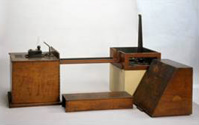
Milne horizontal pendulum seismograph (designated an important cultural asset)
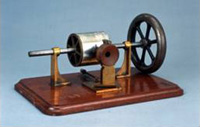
Ewing tinfoil cylinder phonograph (designated an important cultural asset)
Division of History of Science and Technology
The History of Science and Technology Division conducts research on the history of science and technology and studies and collects relevant material, mainly in the areas of mechanical, electrical and electronic, architectural, and civil engineering.
- In the area of mechanical engineering, the division focuses on the study of material related to the history in Japan of machines and measurement devices, and of medical science; and research into the history of advancements in automobiles and aircrafts.
- The history of lighting and household electrical appliances, as well as progress in the Japanese computer industry are topics of research in the area of electrical and electronic engineering.
- In the areas of architectural and civil engineering, the History of Science and Technology Division studies and researches assets that contributed to Japan’s modernization; material related to the history of industrial technologies in Japan; and Japanese railroad facilities.
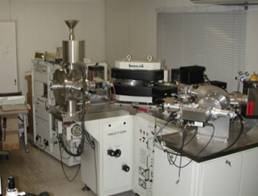
Mass spectrometer used in meteorite research
Division of Physical Sciences
In addition to conducting observational and experimental research in astronomy, geophysics, and chemistry, the Chemistry Division also studies and collects related material and specimens. For example, in the area of astronomy, it carries out observational research on binary and variable stars; in the area of geophysics, research on the mechanical and thermal properties of substances in the Earth’s deep interior; and research on the reaction mechanisms of heterogeneous catalysts, and the early solar system focusing on meteorites, in the area of chemistry. Relevant research material at the Chemistry Division include astronomy-related material such as calendars, telescopes, binoculars, and star globes; seismology-related material such as seismographs and photographs of the aftermath of earthquakes; meteorite samples from most of the meteorite falls in Japan; and information on scientists who contributed to the development of science in Japan, such as Hantaro Nagaoka and Umetaro Suzuki.
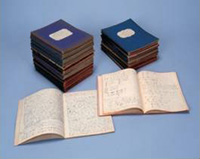
Scientific history material: A notebook of information maintained by Hantaro Nagaoka
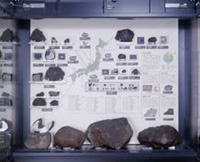
Meteorite display at the Japan Gallery (samples from most meteorite falls in Japan are displayed here)
Team of Artifacts Research
Based on the results of the Museum’s research on science and technology, the Team of Artifacts Research works to clarify the fundamental concepts underlying the design and construction of artifacts and their relation to society.
Specimen collection of the Department of Science and Engineering
The Department of Science and Engineering possesses over 30,000 specimens in its collection. These include specimens that provide information on Japanese scientists and engineers, as well as numerous valuable pieces that trace the history of science and development in Japan. Five specimens, including the Milne horizontal pendulum seismograph have been designated “important cultural assets” of Japan.The specimens managed by the History of Science and Technology Division include clocks, material related to the early automobiles manufactured in Japan, aircraft related material, electronic communication and other information related material, items that contributed greatly to modernization in Japan, carpentry tools, and information on Japanese scientists.
The collection managed by the Chemistry Division includes astronomy-related specimens such as calendars, telescopes, binoculars, and star globes; seismology-related specimens such as seismographs and photographs of the aftermath of an earthquake; meteorite samples from most of the meteorite falls in Japan; and information on scientists who contributed to the development of science in Japan, such as Hantaro Nagaoka and Umetaro Suzuki.





